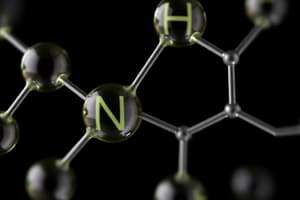Podcast
Questions and Answers
What is polyester made from?
What is polyester made from?
- Natural fibers
- Petrochemicals, a byproduct of oil refining (correct)
- Recycled materials
- A combination of natural and synthetic materials
Polyethylene is a type of thermoset.
Polyethylene is a type of thermoset.
False (B)
What is the importance of recycling synthetic fibers and plastics?
What is the importance of recycling synthetic fibers and plastics?
Conserves natural resources, reduces waste and pollution, and saves energy and reduces greenhouse gas emissions
Nylon is a type of ______________________ fibre.
Nylon is a type of ______________________ fibre.
Match the synthetic fibre with its properties:
Match the synthetic fibre with its properties:
What is a characteristic of polyester fibers?
What is a characteristic of polyester fibers?
Polyethylene is a type of thermoplastic.
Polyethylene is a type of thermoplastic.
What is the main goal of recycling synthetic fibers and plastics?
What is the main goal of recycling synthetic fibers and plastics?
Nylon is a type of ______________________ fiber.
Nylon is a type of ______________________ fiber.
Match the synthetic fiber with its primary use:
Match the synthetic fiber with its primary use:
Flashcards are hidden until you start studying
Study Notes
Synthetic Fibres
Polyester
- Made from petrochemicals, a byproduct of oil refining
- Produced through a process called polycondensation
- Properties:
- Strong and resistant to wrinkles
- Quick drying and easy to care for
- Can be made to mimic the look and feel of natural fibers
- Uses: clothing, upholstery, and industrial applications
Nylon
- A type of polyamide
- Made from adipic acid and hexamethylene diamine
- Properties:
- Strong and resistant to abrasion
- Elastic and resistant to wrinkles
- Can be dyed to achieve a wide range of colors
- Uses: clothing, carpets, and industrial applications
Polyamide
- A type of synthetic fibre that includes nylon and others
- Properties:
- Strong and resistant to abrasion
- Elastic and resistant to wrinkles
- Can be dyed to achieve a wide range of colors
- Uses: clothing, carpets, and industrial applications
Plastics
Polyethylene
- Made from ethylene, a byproduct of oil refining
- Properties:
- Flexible and resistant to chemicals
- Can be made to be transparent or opaque
- Can be recycled
- Uses: packaging, plastic bags, and industrial applications
Types of Plastic
- Thermoplastics: can be melted and reformed multiple times (e.g. polyethylene, polyester)
- Thermosets: cannot be melted and reformed (e.g. epoxy, silicone)
- Bioplastics: made from renewable resources (e.g. corn starch, sugarcane)
Recycling
- Synthetic fibers and plastics can be recycled, but the process is often complex and expensive
- Recycling methods:
- Mechanical recycling: breaking down materials into raw materials
- Chemical recycling: breaking down materials into their chemical components
- Importance of recycling:
- Conserves natural resources
- Reduces waste and pollution
- Saves energy and reduces greenhouse gas emissions
Synthetic Fibres
Polyester
- Derives from petrochemicals, a byproduct of oil refining
- Produced through polycondensation
- Exhibits strength, wrinkle resistance, and quick drying properties
- Can mimic natural fibers' look and feel
- Widely used in clothing, upholstery, and industrial applications
Nylon
- A type of polyamide fibre
- Composed of adipic acid and hexamethylene diamine
- Displays strength, abrasion resistance, and elasticity
- Can be dyed to achieve a wide range of colors
- Finds applications in clothing, carpets, and industrial uses
Polyamide
- A category of synthetic fibres encompassing nylon and others
- Possesses strength, abrasion resistance, and elasticity
- Can be dyed to achieve a wide range of colors
- Used in clothing, carpets, and industrial applications
Plastics
Polyethylene
- Derived from ethylene, a byproduct of oil refining
- Exhibits flexibility, chemical resistance, and transparency
- Can be recycled
- Finds applications in packaging, plastic bags, and industrial uses
Types of Plastic
- Thermoplastics: can be melted and reformed multiple times (e.g. polyethylene, polyester)
- Thermosets: cannot be melted and reformed (e.g. epoxy, silicone)
- Bioplastics: made from renewable resources (e.g. corn starch, sugarcane)
Recycling
- Synthetic fibres and plastics can be recycled, but the process is often complex and expensive
- Mechanical recycling: breaks down materials into raw materials
- Chemical recycling: breaks down materials into their chemical components
- Recycling importance:
- Conserves natural resources
- Reduces waste and pollution
- Saves energy and reduces greenhouse gas emissions
Synthetic Fibers and Plastic
Polyester
- Made from polyethylene terephthalate (PET)
- Produced through a chemical reaction between ethylene glycol and terephthalic acid
- Strong and resistant to wrinkles
- Quick-drying and resistant to moisture
- Can be woven to mimic natural fibers like cotton or wool
Polyethylene
- Type of plastic made from ethylene monomers
- Lightweight and flexible
- Resistant to corrosion and chemicals
- Used in packaging, plastic bags, and containers
Recycling
- Process of collecting and processing used plastic materials to create new products
- Important for reducing waste and conserving natural resources
- Methods include mechanical and chemical recycling
- Mechanical recycling: breaking down plastic into smaller pieces and re-molding
- Chemical recycling: breaking down plastic at a molecular level to recreate raw materials
Polyamide
- Type of synthetic fiber made from polyamide polymers
- Strong and resistant to abrasion
- Good elasticity and wrinkle resistance
- Used in textiles, carpets, and industrial applications
Nylon
- Type of polyamide fiber
- High strength and elasticity
- Resistant to abrasion and chemicals
- Used in textiles, fishing nets, and industrial applications
Types of Plastic and Synthetic Fibers
- Thermoplastics: can be melted and reformed multiple times (e.g. polyethylene, polypropylene)
- Thermosets: cannot be melted and reformed (e.g. polyurethane, epoxy)
- Synthetic fibers: polyester, nylon, polyamide, acrylic, and spandex
Solution to Pollution
- Reduce: minimizing plastic usage and waste
- Reuse: reusing plastic materials whenever possible
- Recycle: recycling plastic materials to create new products
- Proper disposal: disposing of plastic waste in designated areas
Difference between Synthetic and Natural Fibers
- Synthetic fibers:
- Man-made from chemical compounds
- Can mimic natural fibers, but have distinct properties
- Often less expensive and more durable than natural fibers
- Natural fibers:
- Derived from plants, animals, or minerals
- Biodegradable and renewable
- Can be more expensive and less durable than synthetic fibers
Studying That Suits You
Use AI to generate personalized quizzes and flashcards to suit your learning preferences.




